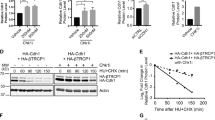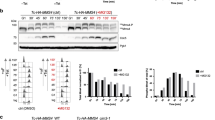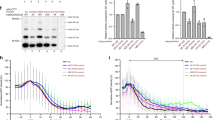Abstract
In late mitosis and G1, a complex of the essential initiation proteins Mcm2–7 are assembled onto replication origins to 'license' them for initiation. At other times licensing is inhibited by cyclin-dependent kinases (CDKs) and geminin, thus ensuring that origins fire only once per cell cycle. Here we show that, paradoxically, CDKs are also required to inactivate geminin and activate the licensing system. On exit from metaphase in Xenopus laevis egg extracts, CDK-dependent activation of the anaphase-promoting complex (APC/C) results in the transient polyubiquitination of geminin. This ubiquitination triggers geminin inactivation without requiring ubiquitin-dependent proteolysis, and is essential for replication origins to become licensed. This reveals an unexpected role for CDKs and ubiquitination in activating chromosomal DNAreplication.
This is a preview of subscription content, access via your institution
Access options
Subscribe to this journal
Receive 12 print issues and online access
$209.00 per year
only $17.42 per issue
Buy this article
- Purchase on Springer Link
- Instant access to full article PDF
Prices may be subject to local taxes which are calculated during checkout





Similar content being viewed by others
References
Blow, J.J. & Hodgson, B. Replication licensing – defining the proliferative state? Trends Cell Biol. 12, 72–78 (2002).
Nishitani, H. & Lygerou, Z. Control of DNA replication licensing in a cell cycle. Genes Cells 7, 523–534 (2002).
Tada, S., Li, A., Maiorano, D., Mechali, M. & Blow, J.J. Repression of origin assembly in metaphase depends on inhibition of RLF-B/Cdt1 by geminin. Nature Cell Biol. 3, 107–113 (2001).
Hodgson, B., Li, A., Tada, S. & Blow, J.J. Geminin becomes activated as an inhibitor of Cdt1/RLF-B following nuclear import. Current Biol. 12, 678–683 (2002).
McGarry, T.J. & Kirschner, M.W. Geminin, an inhibitor of DNA replication, is degraded during mitosis. Cell 93, 1043–1053 (1998).
Wohlschlegel, J.A. et al. Inhibition of eukaryotic replication by geminin binding to Cdt1. Science 290, 2309–2312 (2000).
Chong, J.P., Mahbubani, H.M., Khoo, C.Y. & Blow, J.J. Purification of an MCM-containing complex as a component of the DNA replication licensing system. Nature 375, 418–421 (1995).
Kubota, Y., Mimura, S., Nishimoto, S., Takisawa, H. & Nojima, H. Identification of the yeast MCM3-related protein as a component of Xenopus DNA replication licensing factor. Cell 81, 601–609 (1995).
Madine, M.A., Khoo, C.-Y., Mills, A.D. & Laskey, R.A. MCM3 complex required for cell cycle regulation of DNA replication in vertebrate cells. Nature 375, 421–424 (1995).
Blow, J.J. & Laskey, R.A. A role for the nuclear envelope in controlling DNA replication within the cell cycle. Nature 332, 546–548 (1988).
Blow, J.J. Preventing re-replication of DNA in a single cell cycle: evidence for a replication licensing factor. J. Cell Biol. 122, 993–1002 (1993).
Kubota, Y. & Takisawa, H. Determination of initiation of DNA replication before and after nuclear formation in Xenopus egg cell free extracts. J. Cell Biol. 123, 1321–1331 (1993).
Gillespie, P.J. & Blow, J.J. Nucleoplasmin-mediated chromatin remodelling is required for Xenopus sperm nuclei to become licensed for DNA replication. Nucleic Acids Res. 28, 472–480 (2000).
Gillespie, P.J., Li, A. & Blow, J.J. Reconstitution of licensed replication origins on Xenopus sperm nuclei using purified proteins. BioMed Central Biochem. 2, 15 (2001).
Mahbubani, H.M., Chong, J.P., Chevalier, S., Thömmes, P. & Blow, J.J. Cell cycle regulation of the replication licensing system: involvement of a Cdk-dependent inhibitor. J. Cell Biol. 136, 125–135 (1997).
Meijer, L. et al. Biochemical and cellular effects of roscovitine, a potent and selective inhibitor of the cyclin-dependent kinases cdc2, cdk2 and cdk5. Eur. J. Biochem. 243, 527–536 (1997).
Blow, J.J. & Nurse, P. A cdc2-like protein is involved in the initiation of DNA replication in Xenopus egg extracts. Cell 62, 855–862 (1990).
Zachariae, W. & Nasmyth, K. Whose end is destruction: cell division and the anaphase-promoting complex. Genes Dev. 13, 2039–2058 (1999).
Peters, J.M. The anaphase-promoting complex: proteolysis in mitosis and beyond. Mol. Cell 9, 931–943 (2002).
Luca, F.C. & Ruderman, J.V. Control of programmed cyclin destruction in a cell-free system. J. Cell Biol. 109, 1895–1909 (1989).
Peter, M. et al. The APC is dispensable for first meiotic anaphase in Xenopus oocytes. Nature Cell Biol. 3, 83–87 (2001).
Nishiyama, A. et al. A non-proteolytic function of the proteasome is required for the dissociation of Cdc2 and cyclin B at the end of M phase. Genes Dev. 14, 2344–2357 (2000).
Mahaffey, D., Yoo, Y. & Rechsteiner, M. Ubiquitin metabolism in cycling Xenopus egg extracts. J. Biol. Chem. 268, 21205–21211 (1993).
Bach, I. & Ostendorff, H.P. Orchestrating nuclear functions: ubiquitin sets the rhythm. Trends Biochem. Sci. 28, 189–195 (2003).
Schnell, J.D. & Hicke, L. Non-traditional functions of ubiquitin and ubiquitin-binding proteins. J. Biol. Chem. 278, 35857–35860 (2003).
Su, T.T. & O'Farrell, P.H. Chromosome association of minichromosome maintenance proteins in Drosophila endoreplication cycles. J. Cell Biol. 140, 451–460 (1998).
Coverley, D., Laman, H. & Laskey, R.A. Distinct roles for cyclins E and A during DNA replication complex assembly and activation. Nature Cell Biol. 4, 523–528 (2002).
Chong, J.P., Thömmes, P., Rowles, A., Mahbubani, H.M. & Blow, J.J. Characterization of the Xenopus replication licensing system. Methods Enzymol. 283, 549–564 (1997).
Strausfeld, U.P. et al. Both cyclin A and cyclin E have S-phase promoting (SPF) activity in Xenopus egg extracts. J. Cell Sci. 109, 1555–1563 (1996).
Maiorano, D., Moreau, J. & Mechali, M. XCDT1 is required for the assembly of pre-replicative complexes in Xenopus laevis. Nature 404, 622–625 (2000).
Acknowledgements
Thanks to C. Nieduszynski, S. Shreeram and A. Woodward for comments on the manuscript; to J. Hutchins and P. Clarke for the D-box peptide; to J. Kirk and T. Hunt for the anti-cyclin B antibody; and to J. Walter and T. Prokhorova for the anti-Cdk1 antibody. This work was supported by Cancer Research UK grants SP2385/0101 and C303/A3135.
Author information
Authors and Affiliations
Corresponding author
Ethics declarations
Competing interests
The authors declare no competing financial interests.
Rights and permissions
About this article
Cite this article
Li, A., Blow, J. Non-proteolytic inactivation of geminin requires CDK-dependent ubiquitination. Nat Cell Biol 6, 260–267 (2004). https://doi.org/10.1038/ncb1100
Received:
Accepted:
Published:
Issue Date:
DOI: https://doi.org/10.1038/ncb1100
This article is cited by
-
Geminin Interference Facilitates Vascular Smooth Muscle Cell Proliferation by Upregulation of CDK-1
Cardiovascular Drugs and Therapy (2014)
-
Aurora-A controls pre-replicative complex assembly and DNA replication by stabilizing geminin in mitosis
Nature Communications (2013)
-
DNA replication licensing control and rereplication prevention
Protein & Cell (2010)
-
Replication licensing and cancer — a fatal entanglement?
Nature Reviews Cancer (2008)
-
Cdt1 downregulation by proteolysis and geminin inhibition prevents DNA re-replication in Xenopus
The EMBO Journal (2005)



